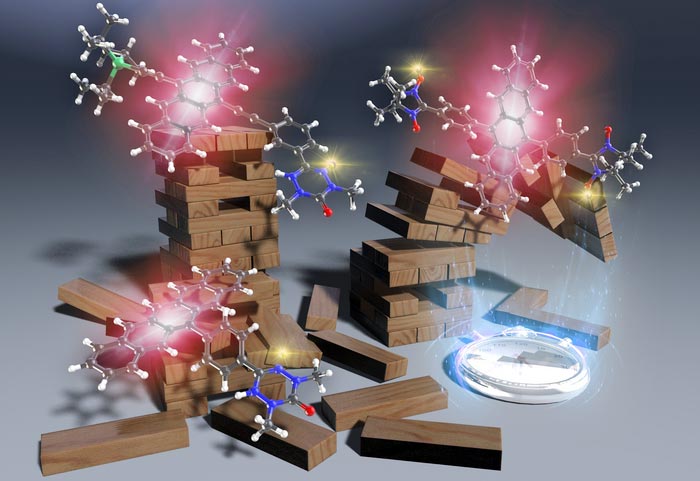Successful development of pentacene derivative

Light instability is a major factor preventing organic semiconductors from being implemented. Researchers from Osaka Metropolitan University demonstrated the ultrafast intersystem crossing of the pentacene moiety in pentacene radical links made the organic semiconductor much more photostable. This is the fastest enhanced intersystem crossing ( 10-13 seconds) demonstrated in a purely organic material without heavy atoms.
Credit: Yoshio Teki
… that has 100 times more light durability than conventional products.
Osaka Metropolitan University scientists synthesize new photostable organic semiconductor.
Due to their high hole mobility, pentacene and its derivatives have been the representative organic semiconductors and have been the subject of much research, both basic and applied. In particular, they are expected to be applied to semiconductor devices such as field-effect transistors. In addition, organic semiconductors have the advantage of being inexpensive to produce by inkjet printing and having low environmental impacts because they do not use metals. However, the backbone of organic semiconductors such as pentacene easily reacts with oxygen molecules under visible light, resulting in the loss of useful properties.
A research group led by Professor Yoshio Teki of the Graduate School of Engineering, Osaka Metropolitan University, has achieved photostability more than 100 times higher than that of TIPS-pentacene, a famous commercially-available pentacene derivative, by increasing the planarity of the molecule and strengthening the conjugation of π electrons between a radical substituent and pentacene moiety. At the same time, to elucidate the mechanism of the remarkable photostability, ultrafast transient absorption measurements using a femtosecond pulsed laser were performed to clarify the peculiar excited-state dynamics of this system.
Focusing on the pentacene moiety of the system, they found that intersystem crossing occurs at an ultrafast rate (10-13 seconds), which has never been achieved before in purely organic materials containing no heavy atoms. Furthermore, the subsequent ultrafast deactivation to the ground state was observed to occur within a time of about 10-10 seconds.
“Excellent photostability was achieved by adding a radical substituent that enhances the planarity of the molecules and strengthens the conjugation of π electrons,” stated Professor Teki. “In the future, we would like to verify the performance of field-effect transistors and apply them as organic semiconductors.”
This article was featured on the back cover of Physical Chemistry Chemical Physics.
About OMU
Osaka Metropolitan University is a new public general university established by a merger between Osaka City University and Osaka Prefecture University in April 2022. For more science news, see https://www.upc-osaka.ac.jp/new-univ/en-research/, and follow @OsakaMetUniv_en, or search #OMUScience.
Journal: Physical Chemistry Chemical Physics
DOI: 10.1039/d2cp00683a
Method of Research: Experimental study
Subject of Research: Not applicable
Article Title: π-Topology and ultrafast excited-state dynamics of remarkably photochemically stabilized pentacene derivatives with radical substituents
Article Publication Date: 11-Apr-2022
Media Contact
Akane Kunida
Osaka Metropolitan University
kunida@omu.ac.jp
All latest news from the category: Materials Sciences
Materials management deals with the research, development, manufacturing and processing of raw and industrial materials. Key aspects here are biological and medical issues, which play an increasingly important role in this field.
innovations-report offers in-depth articles related to the development and application of materials and the structure and properties of new materials.
Newest articles

Superradiant atoms could push the boundaries of how precisely time can be measured
Superradiant atoms can help us measure time more precisely than ever. In a new study, researchers from the University of Copenhagen present a new method for measuring the time interval,…

Ion thermoelectric conversion devices for near room temperature
The electrode sheet of the thermoelectric device consists of ionic hydrogel, which is sandwiched between the electrodes to form, and the Prussian blue on the electrode undergoes a redox reaction…

Zap Energy achieves 37-million-degree temperatures in a compact device
New publication reports record electron temperatures for a small-scale, sheared-flow-stabilized Z-pinch fusion device. In the nine decades since humans first produced fusion reactions, only a few fusion technologies have demonstrated…





















